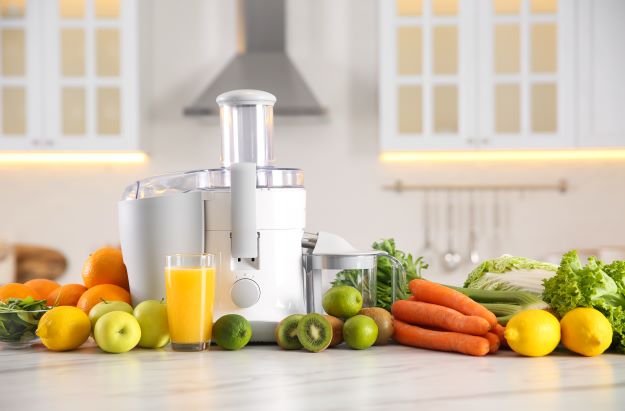
How to Disassemble a Juicer
- Shamima
- July 21, 2023
- 2:17 pm
- No Comments
Learn how to disassemble a juicer in 7 simple steps. Also, discover effective ways to clean and troubleshoot common juicer problems and possible risks.
Disassembling a juicer is a vital skill to keep it clean. Also, it ensures smooth operation and durability.
This guide will give you the simple steps to disassemble a juicer. You will also learn effective ways to clean and troubleshoot common problems.
First things first…

What Are the Parts of a Juicer?
A juicer has several parts that work together to extract the juice. These parts include.
Feeding Chute: This is the part where you put the ingredients for juice extraction.
Cutting Blades: These sharp blades cut the ingredients to make juice.
Strainer: The strainer filters the pulp and any solid particles from the juice.
Pulp Container: This container collects pulp remains after juicing. Always ensure it’s empty during the juicing process.
Juice Collector: This container collects the extracted juice for consumption or storage.
Motor Base: The motor base hosts the motor, which powers the juicer. In essence, it provides the torque to process fruits and vegetables.
Control Panel: The control panel has buttons r and knobs to operate your juicer. From the panel, you can adjust speed, settings, and functions.
Safety Features: Some juicers have locking mechanisms and overload protection features.
These features protect your juicer from overload and ensure your safety.
Why Do We Need to Disassemble a Juicer?
Here are some reasons you may need to disassemble your juicer.
Cleaning
Like any other kitchen appliance, you should clean your juicer regularly. This ensures proper food hygiene and prevents a build-up of debris and pulp.
We all want to do our work in an easy and effective way. This applies to cleaning juicers too. And the best way to clean a juicer starts by disassembling it. This will allow you easy access and cleaning of nooks and crannies.
Maintenance
After cleaning, check for wear and tear, which may cause malfunctioning and inefficiency. Replace or repair the worn-out parts.
Remember to check exposed or worn-out electrical cables. They may give you a nasty electrical shock.
Troubleshooting
As you use your juicer over time, its efficiency will decline or malfunction. It’s time to pick your tools and disassemble your juice.
Taking it apart helps to troubleshoot what is causing it to malfunction.
Inspect various parts for blockages and other issues as you disassemble your juicer.
Storage and Transport
Another reason you may want to disassemble your juicer is for easy storage or transport.
Taking it apart makes it more compact to fit into a box.
Disassembling a juicer could be quick and easy, but it comes with risks.
So…
What Are the Risks of Disassembling a Juicer?
Although disassembling a juicer is safe, take note of the following risks.
Personal Injury
Always be careful when disassembling a juicer. You could get minor and, in extreme cases, a major injury. So whatever you do, give your personal safety high priority.
Juicers have sharp blades and edges that can cause cuts or injuries when mishandled. To avoid injuries, work slowly, observe safety procedures, and follow the manufacturer’s instructions.
Electrical Hazards
Electric shock is a dangerous and life-threatening risk while disassembling a juicer.
Never attempt to disassemble an electric juicer connected to a power outlet. First, switch off the juicer and sockets, then unplug it.
Components Damage
Wrong disassembling or using excess force can damage some of its components. Some damages can compromise its performance or even render it unusable.
So, always read the manufacturer’s disassembly instructions before taking it apart. And always use the correct tools.
Voiding Warranty
Disassembling the juicer when it’s still under warranty can void it. The best thing is to check the warranty terms and conditions before disassembling it.
Necessary Tools to Disassemble a Juicer
Your juicer design and model determine your necessary tools to disassemble it. Here are a few common tools you’ll need for the process:
Screwdriver
A screwdriver is a common tool you will need to take your juicer apart. You’ll often need a screwdriver to remove screws holding different juicer parts together. The specific type required will depend on the screw heads used in your juicer.
Wrench
Sometimes, you will also need a wrench to loosen or tighten certain components with nuts or bolts.
Pliers
This is another handy tool to grip and turn small parts or connectors. Especially those which are difficult to handle with your bare hands.
Cleaning Brush
A cleaning brush is not a disassembling tool; you need it to clean hard-to-reach areas. Some of these parts include the filter or pulp container.
Soft Cloth or Towel
A soft cloth or towel is useful for wiping down parts and keeping them clean as you disassemble the juicer.
But note that not all juicers need disassembling tools. Some models’ design is easy to disassemble and reassemble without extra tools. Consult your juicer user manual to determine the tools you need to disassemble.
Once you have all the necessary tools, here is a step-by-step guide.
How to Disassemble a Juicer: Step-by-step Guide
The procedure to disassemble your juicer depends on its model and design. Here is a general guideline applicable to most juicers;
1. Unplug the Juicer from the Power Supply
Disconnect and unplug your juicer from the power supply to avoid electrical accidents.
2. Remove Removable Parts from the Juicer
After disconnecting your juicer, remove all detachable parts. The likes of feeding chute, pulp container, and juice collector.
Generally, these parts’ design is easy to lift or slide off the main juicer body.
3. Disconnect the Motor
If your juicer design allows, disconnect the motor from the juicer body. You may need to unscrew or release any clips or fasteners securing the motor in place.
4. Remove the Juice Extractor
The juice extractor is among the most important juicer components. The reason it contains the cutting blades and strainer. To remove, unlock or twist to release it from the juicer body.
5. Remove the Juicing Screen from the Juicer
Depending on your juicer design and model, it may contain a separate juicing screen or filter. Unlock or twist the screen to release it from the juicer.
6. Clean the Juicer
It’s time to clean after disassembling and removing all the removable parts. Use warm water and mild dishwashing detergent. Give special attention to hard-to-reach points where juice pulp and residue accumulate. Moreover, please follow the user manual cleaning recommendations.
7. Allow the Parts to Dry
After cleaning, dry the parts on a clean surface before reassembling the juicer. You can air dry them or wipe off excess water using a soft cloth, then assemble them.
Additionally, there are things to avoid when disassembling your juicer.
Things You Should Avoid When Disassembling a Juicer
Here are safety tips to note when disassembling your juicer. Safety precautions help to prevent damage and injuries. You should avoid;
Washing Parts in Boiling Water
You must not wash any part in boiling water. High temperatures can damage some components, like plastics or rubber seals. Possible damages include; warping, melting, or sometimes interfering with their functionality. Instead, check and follow the manufacturer’s instructions on temperature limits.
Using a Cleaning Brush or Knife for Pushing
Do not use a cleaning brush or knife to push or pry apart juicer parts forcefully. These tools can damage or scratch delicate components, altering their performance and longevity.
Instead, follow the manufacturer’s disassembling instructions. Also, you should use appropriate tools to disassemble.
After cleaning or maintenance, it’s now time to reassemble the components.
How to Reassemble the Juicer?
Follow these general steps to reassemble your juicer after cleaning.
Clean and Dry all Parts: Ensure all parts are clean, dry, and residue-free.
Refer to the User Manual: Follow the manufacturer’s instructions to reassemble your juicer. Also, the manual might have safety precautions to avoid damage and injuries.
Reverse the Disassembly Order: Reassembling is generally the reverse of the disassembly process. This means the first part to remove will be the last to reassemble and vice versa.
Follow the reverse order to reattach the parts. Also, align and secure all the parts properly.
Attach the Juicing Screen and Juice Extractor: Attach the Juicing screen according to the manual. Then the juice extractor on the top. Finally, twist or lock it into place following the manufacturer’s instructions.
Reconnect the Motor: If your juicer motor disconnects, reconnect it to the juicer body. To do this, align it to its position and fasten any clips and screws.
Reattach Removable Parts: Attach the juice collector, pulp container, and other loose parts. Follow the user manual as you twist or slide them into position. Then, confirm that all the parts are in place and firm.
Your juicer is ready for use. But if you notice any problems, here are a few tips.
How to Troubleshoot the Issues After Reassembling?
If you encounter any issues after reassembling your juicer. Here are some troubleshooting tips to resolve the problems:
Check for Loose or Misaligned Parts
Confirm that all the parts align correctly and are firm. Your juicer may fail to function due to loose and improperly fitting parts.
Verify Power Connection
Check that the juicer is correctly plugged into a functioning power outlet. Connect the battery correctly and confirm it has enough charge if it’s cordless.
Examine Blades and Strainer
Check the strainer, juicing screen, and cutting blade. Make sure they are clean without any obstructions. Residue and pulp can hinder efficient juicer performance. So, it’s important to ensure they are clean at all times.
Check for Blockages
Look for possible blockages if the juicer is inefficient and not extracting juice. The cutting blades, feeding chute, or strainer may have residues hindering their efficiency. Disassemble the necessary parts and clear any debris or clogs to resolve this.
Review Safety Features
Some juicers’ safety features only allow operation once you assemble all the parts. Look out for the proper functioning of the safety features before using the juicer.
After troubleshooting, it’s time to test the juicer for proper functioning.
Testing the Juicer After Reassembly
After reassembling, it’s time to test your juicer’s functioning. To do this;
Power On: Plug your juicer into a functional power outlet. For cordless juicers using a battery, connect it properly before you proceed.
Recheck Parts: Verify that all the reassembled parts are secure and properly aligned. These include the feeding chute, cutting blades, juicing screen, and pulp container.
Collect Test Ingredients: You’ll need ingredients to juice as you test functionality. Clean and dice the large ones ready for juicing.
Start the Juicer: Turn your juicer on appropriately.
Feed Ingredients: Feed your test ingredients into the juicer feeding chute. Then observe how it handles the ingredients and extracts the juice.
Track Performance: Take note of the juicer’s performance. Pay special attention to its efficiency and speed. Juicer performance refers to the extract’s smoothness, features, and settings functionality.
Check for Issues: Look out for any abnormal issues. These include leaks, excess vibrations, abnormal noise, excessive vibrations, and other irregularities. If you notice any problem, address it promptly to avoid more damage.
Clean and Maintain: If you are comfortable with the performance, clean it for your next use. Cleaning helps to maintain its performance and longevity.
Testing your juicer after reassembly ensures its functionality and readiness for use. But, there are safety precautions to consider.
Safety Precautions
When using your juicer, please follow these safety precautions:
Read the Manual: Before using your juicer, read and follow the manufacturer’s instructions.
Unplug When Not in Use: Always unplug your juicer when not in use.
Avoid Overloading: Only fill your blender to the recommended capacity; don’t overfill.
Use Pusher: Don’t use your hands to guide the juicing ingredients. Instead, use a pusher or plunger to guide the ingredients into the juicer.
Keep Hands Away: When operating, keep your fingers, hands, and other objects from the juicer. These safety precautions help to avoid personal injury and juicer damage.
Disconnect in Case of Malfunctions: In case of malfunctions when in use, switch off immediately. Also, unplug it and contact customer support for help to avoid further damage.
The above safety precautions enhance your safety and juicing experience.
Final Words
It’s important to know how to disassemble a juicer for some reasons. You may need to disassemble it for proper maintenance, troubleshooting, and cleaning. It makes accessing and cleaning all parts and components easy for efficient performance.
Please note that there are possible risks that come with disassembling. That’s why you need to follow safety precautions and avoid common mistakes.
Use appropriate tools to disassemble and reassemble your juicer. You also need to test it after reassembly for proper functioning.
Frequently Asked Questions
Can the juicer be repaired?
Yes. It’s possible to repair your juicer depending on the damage or malfunction. For instance, simple issues like worn-out parts or clogs need replacement and cleaning. But in cases of complex issues, consult a professional.
Do different juicers have totally different disassembly processes?
Yes, juicers have different disassembly processes. The juicer manufacturer, model, and design determine its assembling and disassembling. That’s why you should follow the user manual specific to your juicer model.
Table of Contents
ToggleShamima
I am working in a restaurant. One of the responsibilities is to monitor the Kitchen Appliances’ performance and inform the maintenance department. Sometimes, I work closely with the maintenance team. I have gained some knowledge of kitchen appliances from there and want to share it with you. I have a passion for explaining my understanding simply.
DISCLAIMER
Ponnopick intends to provide guidelines other than advice. We help buyers better understand the product.
INCOME DISCLOSURE
We have used affiliate links in the articles, and we may earn a commission through successful purchases from that links.










